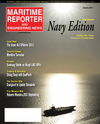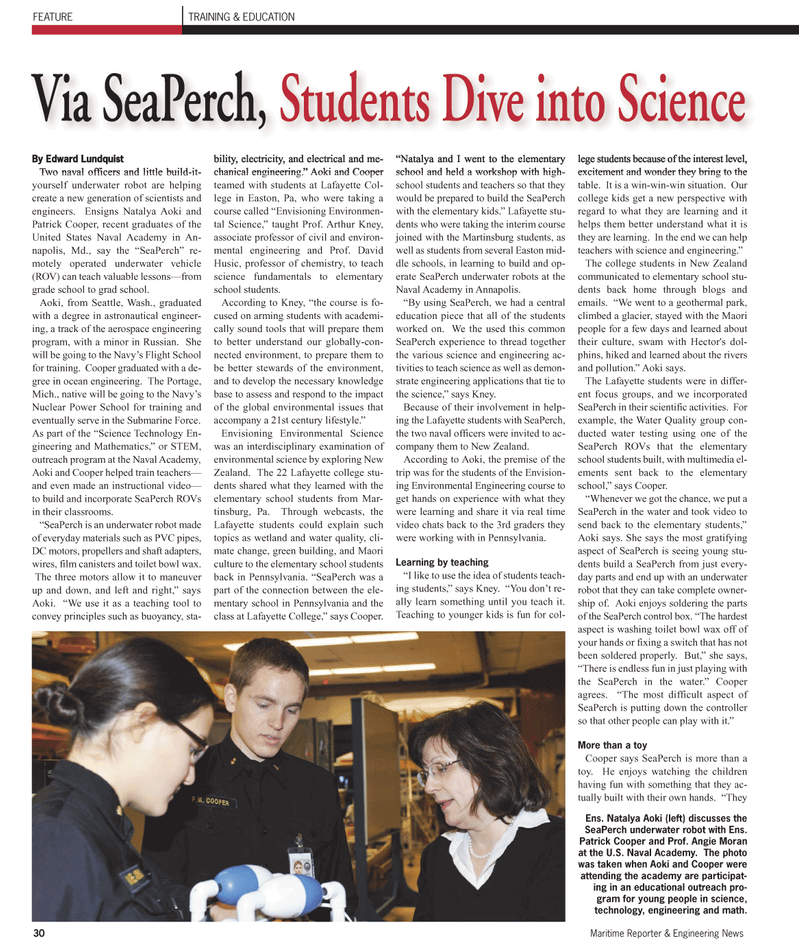
Page 30: of Maritime Reporter Magazine (January 2011)
International Naval Technology
Read this page in Pdf, Flash or Html5 edition of January 2011 Maritime Reporter Magazine
30 Maritime Reporter & Engineering News
FEATURE TRAINING & EDUCATION
By Edward Lundquist
Two naval officers and little build-it- yourself underwater robot are helping create a new generation of scientists and engineers. Ensigns Natalya Aoki and
Patrick Cooper, recent graduates of the
United States Naval Academy in An- napolis, Md., say the “SeaPerch” re- motely operated underwater vehicle (ROV) can teach valuable lessons—from grade school to grad school.
Aoki, from Seattle, Wash., graduated with a degree in astronautical engineer- ing, a track of the aerospace engineering program, with a minor in Russian. She will be going to the Navy’s Flight School for training. Cooper graduated with a de- gree in ocean engineering. The Portage,
Mich., native will be going to the Navy’s
Nuclear Power School for training and eventually serve in the Submarine Force.
As part of the “Science Technology En- gineering and Mathematics,” or STEM, outreach program at the Naval Academy,
Aoki and Cooper helped train teachers— and even made an instructional video— to build and incorporate SeaPerch ROVs in their classrooms. “SeaPerch is an underwater robot made of everyday materials such as PVC pipes,
DC motors, propellers and shaft adapters, wires, film canisters and toilet bowl wax.
The three motors allow it to maneuver up and down, and left and right,” says
Aoki. “We use it as a teaching tool to convey principles such as buoyancy, sta- bility, electricity, and electrical and me- chanical engineering.” Aoki and Cooper teamed with students at Lafayette Col- lege in Easton, Pa, who were taking a course called “Envisioning Environmen- tal Science,” taught Prof. Arthur Kney, associate professor of civil and environ- mental engineering and Prof. David
Husic, professor of chemistry, to teach science fundamentals to elementary school students.
According to Kney, “the course is fo- cused on arming students with academi- cally sound tools that will prepare them to better understand our globally-con- nected environment, to prepare them to be better stewards of the environment, and to develop the necessary knowledge base to assess and respond to the impact of the global environmental issues that accompany a 21st century lifestyle.”
Envisioning Environmental Science was an interdisciplinary examination of environmental science by exploring New
Zealand. The 22 Lafayette college stu- dents shared what they learned with the elementary school students from Mar- tinsburg, Pa. Through webcasts, the
Lafayette students could explain such topics as wetland and water quality, cli- mate change, green building, and Maori culture to the elementary school students back in Pennsylvania. “SeaPerch was a part of the connection between the ele- mentary school in Pennsylvania and the class at Lafayette College,” says Cooper. “Natalya and I went to the elementary school and held a workshop with high- school students and teachers so that they would be prepared to build the SeaPerch with the elementary kids.” Lafayette stu- dents who were taking the interim course joined with the Martinsburg students, as well as students from several Easton mid- dle schools, in learning to build and op- erate SeaPerch underwater robots at the
Naval Academy in Annapolis. “By using SeaPerch, we had a central education piece that all of the students worked on. We the used this common
SeaPerch experience to thread together the various science and engineering ac- tivities to teach science as well as demon- strate engineering applications that tie to the science,” says Kney.
Because of their involvement in help- ing the Lafayette students with SeaPerch, the two naval officers were invited to ac- company them to New Zealand.
According to Aoki, the premise of the trip was for the students of the Envision- ing Environmental Engineering course to get hands on experience with what they were learning and share it via real time video chats back to the 3rd graders they were working with in Pennsylvania.
Learning by teaching “I like to use the idea of students teach- ing students,” says Kney. “You don’t re- ally learn something until you teach it.
Teaching to younger kids is fun for col- lege students because of the interest level, excitement and wonder they bring to the table. It is a win-win-win situation. Our college kids get a new perspective with regard to what they are learning and it helps them better understand what it is they are learning. In the end we can help teachers with science and engineering.”
The college students in New Zealand communicated to elementary school stu- dents back home through blogs and emails. “We went to a geothermal park, climbed a glacier, stayed with the Maori people for a few days and learned about their culture, swam with Hector's dol- phins, hiked and learned about the rivers and pollution.” Aoki says.
The Lafayette students were in differ- ent focus groups, and we incorporated
SeaPerch in their scientific activities. For example, the Water Quality group con- ducted water testing using one of the
SeaPerch ROVs that the elementary school students built, with multimedia el- ements sent back to the elementary school,” says Cooper. “Whenever we got the chance, we put a
SeaPerch in the water and took video to send back to the elementary students,”
Aoki says. She says the most gratifying aspect of SeaPerch is seeing young stu- dents build a SeaPerch from just every- day parts and end up with an underwater robot that they can take complete owner- ship of. Aoki enjoys soldering the parts of the SeaPerch control box. “The hardest aspect is washing toilet bowl wax off of your hands or fixing a switch that has not been soldered properly. But,” she says, “There is endless fun in just playing with the SeaPerch in the water.” Cooper agrees. “The most difficult aspect of
SeaPerch is putting down the controller so that other people can play with it.”
More than a toy
Cooper says SeaPerch is more than a toy. He enjoys watching the children having fun with something that they ac- tually built with their own hands. “They
Via SeaPerch, Students Dive into Science
Ens. Natalya Aoki (left) discusses the
SeaPerch underwater robot with Ens.
Patrick Cooper and Prof. Angie Moran at the U.S. Naval Academy. The photo was taken when Aoki and Cooper were attending the academy are participat- ing in an educational outreach pro- gram for young people in science, technology, engineering and math.

 29
29

 31
31
